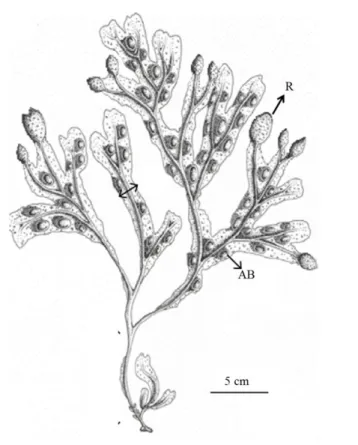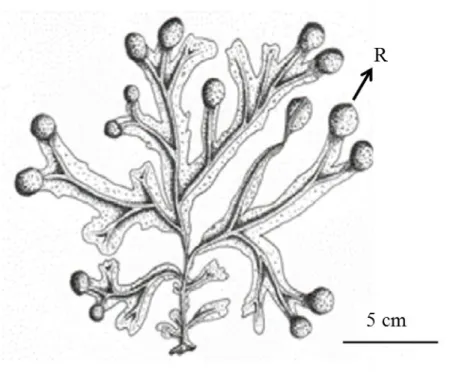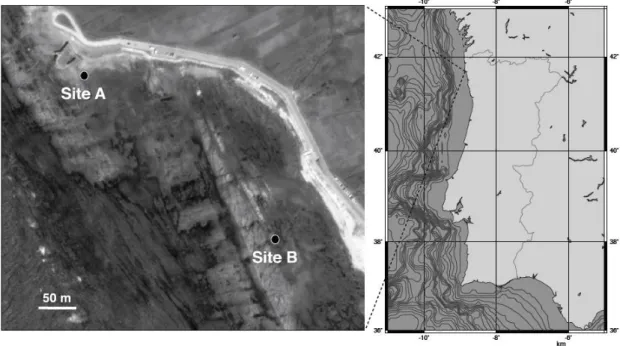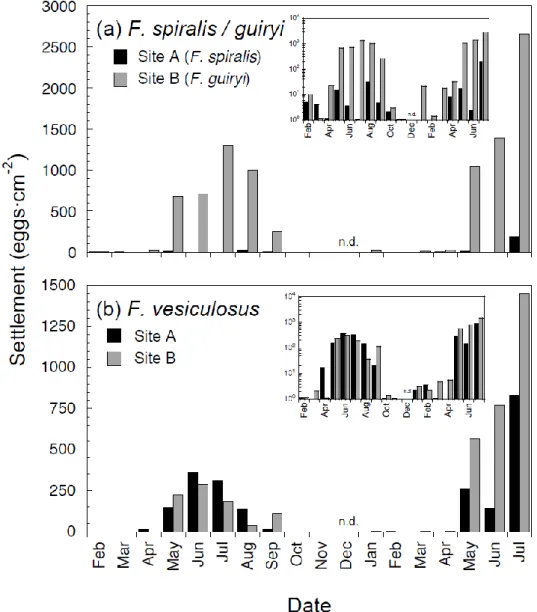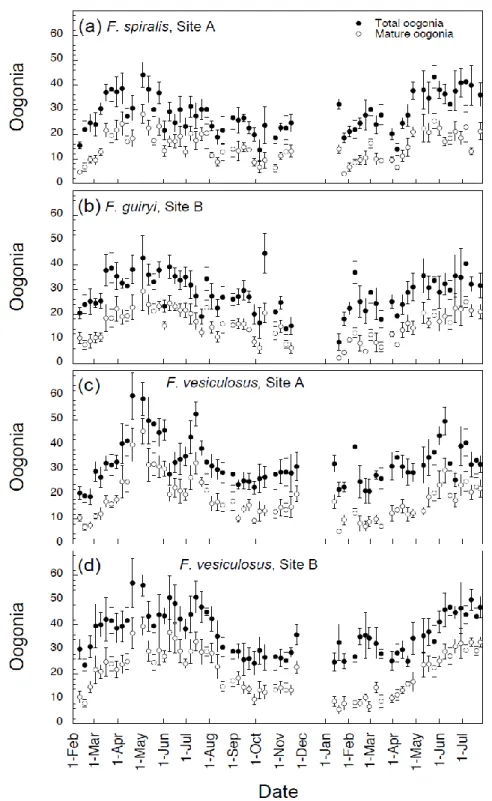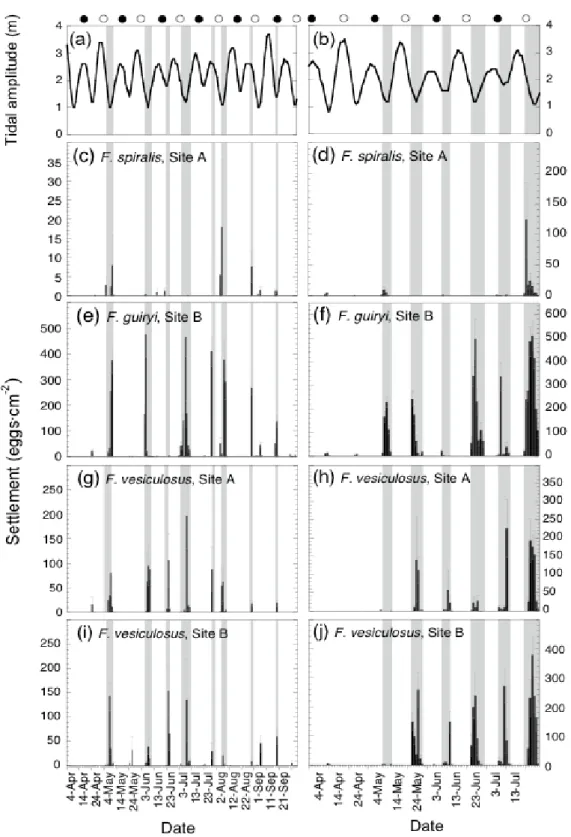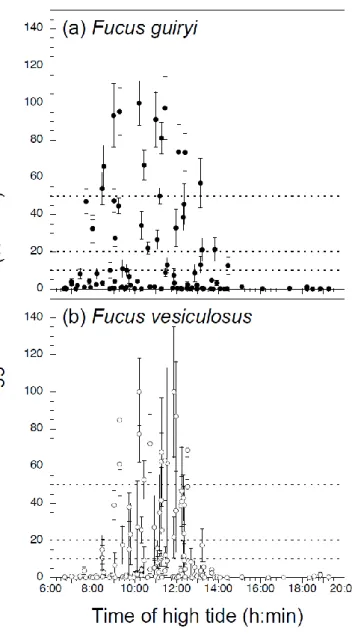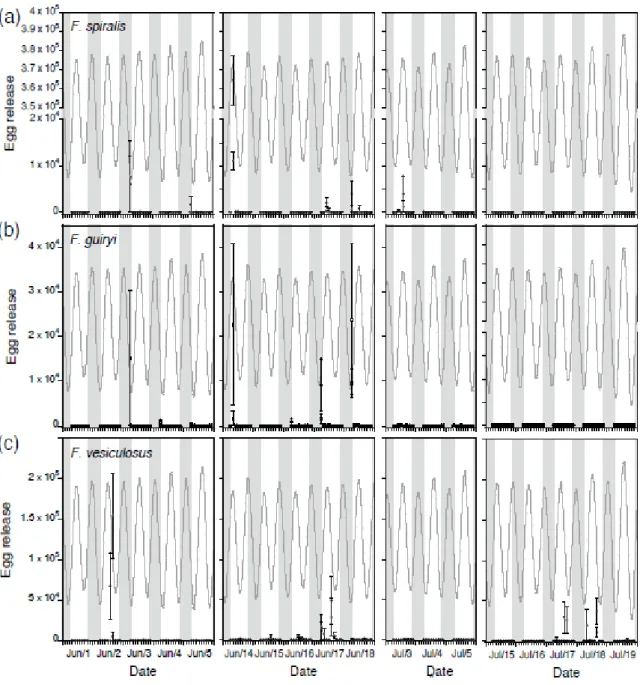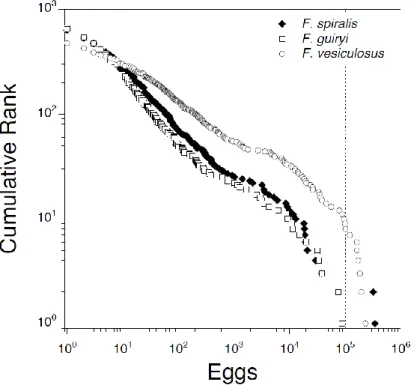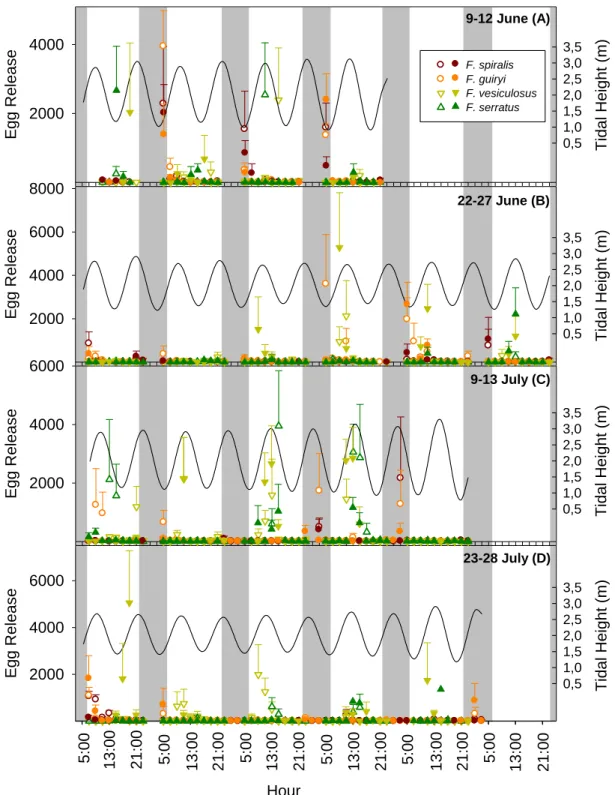FCT
FACULDADE DE CIÊNCIAS E TECNOLOGIA1
sympatric intertidal fucoid algae – when and why
DECLARAÇÃO DE AUTORIA DE TRABALHO:
Declaro ser a autora deste trabalho, que é original e inédito. Autores e trabalhos consultados estão devidamente citados no texto e constam da listagem de referências incluídas.
_____________________________________
(c) Copyright: Carla Alexandra da Silva Monteiro
A Universidade do Algarve tem o direito, perpétuo e sem limites geográficos, de arquivar e publicitar este trabalho através de exemplares impressos reproduzidos em papel ou de forma digital, ou por qualquer outro meio conhecido ou que venha a ser inventado, de o divulgar através de repositórios científicos e de admitir a sua cópia e distribuição com objectivos educacionais ou de investigação, não comerciais, desde que seja dado crédito ao autor e editor.
3
This thesis was funded by Portuguese Science Foundation (FCT) through the grant SFRH / BD / 66673/ 2009 and the by projects EDGES PTDC/AAC-CLI/109108/2008, EXTANT EXCL/AAG-GLO/0661/2012 and HYBRID PTDC/MAR/108105/2008. And also supported by CCMAR – MULTI/04326 and co-sponsored by FEDER (ERDF, European Regional Development Fund). The European Union Network of Excellence MARBEF-Marine Biodiversity and Ecosystem Function and the NSF (USA) CORONA network provided opportunities for interesting insights and discussions on the topic of this study.
Apoio
A presente tese teve o apoio da Fundação para a Ciência e Tecnologia (FCT), através da bolsa SFRH / BD / 66673/ 2009 e dos projetos EDGES PTDC/AAC-CLI/109108/2008, EXTANT EXCL/AAG-GLO/0661/2012 e HYBRID PTDC/MAR/108105/2008. E o apoio de CCMAR – MULTI/04326 e co-patrocinado FEDER (ERDF, Fundo Europeu de Desenvolvimento Regional). A Rede de Excelência da União Europeia MARBEF-Marine Biodiversity and Ecosystem Function e NSF (USA) CORONA network, criaram oportunidades de interesse e discussão de alguns tópicos deste estudo.
5
“O valor das coisas não está no tempo que elas duram, mas na intensidade com que acontecem. Por isso existem momentos inesquecíveis, coisas inexplicáveis e pessoas incomparáveis.”
Maria Júlia Paes em “Qual é o tempo do cuidado”
Esta tese não teria sido possível sem o contributo precioso de pessoas incomparáveis que me proporcionaram momentos inesquecíveis, mesmo quando as coisas inexplicáveis pareciam não ter fim. Um agradecimento sincero às pessoas incomparáveis:
Em primeiro lugar, quero agradecer aos meus orientadores, pela total disponibilidade, paciência, pela transmissão de conhecimentos e especialmente pela generosidade ao longo de muitos e bons anos. Um especial agradecimento à Ester, por ter sempre conseguido facilitar as amostragens com a toda a “logística” que os trabalhos exigiram. E ao Gareth por ter efectuado amostragens, que muito contribuíram para o desenrolar desta tese. E por fim, um agradecimento pela revisão minuciosa a esta tese. Um sincero agradecimento por tudo.
À associação “Amigos do Mar” pela cedência do espaço, pela total disponibilidade e pelo caloroso acolhimento, ao longo de tantos anos.
Aos que me ajudaram nos trabalhos de laboratório e de campo. Não vou enumerar nomes, porque a minha memória neste momento iria-me atraiçoar e não quero que alguém seja excluído. Por isso, agradeço a todos aqueles que trabalharam arduamente comigo, porque não foi fácil, pois foi necessário muito esforço físico e psicológico para desempenhar muitas das tarefas propostas.
À Ana Amaral pela amizade e companheirismo.
Um agradecimento à Cristina Paulino e à Rita Jacinto, por terem formado uma equipa coesa e imparável.
6
Aos meus avós, mesmo na ausência física a vossa presença permanecerá para sempre no meu coração.
Aos meus pais, pelo apoio, mesmo quando não compreendem os meus “desvaneios e preferências” profissionais. Um agradecimento especial à minha mãe que durante vários meses esteve comigo, e foi uma avó extremamente presente e cuidadosa. Permitindo que o meu filho, no primeiro ano de vida tenha recebido toda a atenção, carinho e muitos mimos que só uma avó sabe dar. Ao meu pai pela compreensão nas ausências prolongadas da minha mãe.
Ao meu irmão, porque mesmo longe partilhamos e “caminhamos” juntos nesta jornada. Um agradecimento por toda a bibliografia que solicitei e pela paciência. E claro, parabéns pelos objectivos concretizados.
Ao Luís, por tudo…pela compreensão nas ausências prolongadas, pelo apoio especial nos momentos mais difíceis ao longo destes anos. Especialmente, pelo apoio incondicional no início da nossa vida a três que se cruzou com esta tese.
Quando acabei a minha tese licenciatura, dediquei o meu trabalho aos meus pais, eles tornaram possível o meu desejo profissional. Aos meus avós dediquei a minha tese de mestrado, pois são os alicerces da minha vida. Hoje, e após 3 anos de ser mãe dedico esta tese ao meu filho, Pedro, que veio preencher a minha vida, com um amor indescritível e uma felicidade imensa.
7
In sympatric assemblages of congeners with incomplete reproductive barriers, the synchrony within species and asynchrony between species may be under strong selection, reinforcing prezygotic reproductive isolation and reducing hybridization. Interspecific asynchrony and gametic incompatibility are considered the two most important prezygotic mechanisms reinforcing assortative mating and acting against hybridization. However, divergence of reproductive strategies in closely related species might also contribute to reproductive isolation. The main goal of this thesis was to investigate hypotheses concerning the mechanisms that act against hybridization in sympatric species with external fertilization, including the asynchrony of gamete release, mating system variations and gametic incompatibility.
As a model we used sympatric Fucus species with different reproductive modes, hermaphroditic (selfing) and dioecious (obligate outcrossing). The results show a clear relationship between patterns of gamete release and tidal/circadian cycles that contributes to interspecific variation in spawning time between hermaphroditic and dioecious species. The data support the hypothesis that asynchronous egg release acts as a prezygotic barrier to hybridization between hermaphroditic and dioecious species, and therefore, that mating system variation between congeners plays important role against hybridization. We also provide evidence that gametic incompatibility is an incomplete prezygotic barrier between
Fucus species. Results show the potential of interspecific fertilization, and the potential
growth and survival of hybrids relative to the parental lineage.
Keywords: External fertilization; Hybridization; Mating system; Pre- and postzygotic barriers; Sympatric species; Synchrony of release
8
A libertação síncrona dos gâmetas entre indivíduos da mesma espécie e a libertação assíncrona entre indivíduos de espécies diferentes, pode estar sob uma selecção forte, de forma a reforçar o isolamento reprodutivo pré-zigótico e reduzir a hibridação entre populações congéneres que vivem em simpatria e possuem barreiras reprodutoras incompletas. Os mecanismos pré-zigóticos mais importantes contra a hibridação são a libertação assíncrona entre espécies e a incompatibilidade entre os gâmetas. No entanto, estratégias reprodutoras divergentes entre congéneres podem também contribuir para o isolamento reprodutor. O objectivo principal desta tese foi testar as hipóteses relacionadas com os mecanismos que actuam contra a hibridação entre espécies congéneres, que vivem em simpatria e apresentam fertilização externa. Os mecanismos estudados foram a libertação assíncrona dos gâmetas, a variação dos sistemas de acasalamento e a incompatibilidade entre gâmetas de espécies diferentes. Como modelo de estudo usamos espécies simpátricas do género Fucus, e com estratégias reprodutoras diferentes, hermafroditas (autofertilização) e dióicas (fertilização cruzada). Os resultados sugerem claramente uma forte relação entre os padrões de libertação dos gâmetas e os ciclos de marés e os circadianos, que contribuem para a libertação assíncrona entre espécies hermafroditas e dióicas. Estas observações suportam também, a hipótese da importância dos diferentes modos de acasalamento contra a hibridação. No entanto, os resultados demonstram que a incompatibilidade gamética ente espécies de Fucus não é um mecanismo pré-zigótico contra a hibridação e que existe um potencial de fertilização interespecífica. E por fim, os resultados indicam um potencial crescimento e sobrevivência dos híbridos relativamente à linhagem parental.
Palavras-Chave: Barreiras pré- e pós-zigóticas; Espécies simpátricas; Fertilização externa; Hibridação; Libertação síncrona; Sistemas de acasalamento
9
A libertação síncrona dos gâmetas em organismos com fertilização externa tem implicações importantes no sucesso de fertilização e recrutamento, e consequentemente no sucesso reprodutor. No entanto, em espécies simpátricas e com barreiras reprodutoras incompletas, a libertação síncrona dos gâmetas entre indivíduos da mesma espécie (sincronia intra-específica), e a libertação assíncrona entre indivíduos de espécies diferentes (asincronia interespecífica), pode estar sob uma selecção forte, de forma a reforçar o isolamento reprodutivo pré-zigótico e reduzir a hibridação. Várias observações demonstraram que a libertação dos gâmetas entre congéneres é usualmente assíncrona, podendo ocorrer em escalas temporais mais ou menos restritas (e.g. intervalos mais restritos de horas), mas que podem evitar a hibridação. Para além disso, a libertação assíncrona entre espécies e a incompatibilidade gamética são considerados os mecanismos pré-zigóticos mais importantes contra a hibridação. No entanto, a evolução de estratégias reprodutoras divergentes em espécies estritamente relacionadas, podem também contribuir para o isolamento reprodutor, i.e., os sistemas de acasalamento diferentes podem actuar como um mecanismo ecológico contra a hibridação. Enquanto, nas espécies dióicas, o cruzamento obrigatório entre indivíduos aumenta a variação genética intra-populacional, e o tamanho efectivo da população (em comparação com as espécies que se auto-fertilizam), nas espécies hermafroditas, a autofertilização pode contribuir para o desenvolvimento do isolamento reprodutivo e especiação.
Os objectivos principais desta tese foram testar as hipóteses relacionadas com os mecanismos ecológicos que actuam contra a hibridação entre espécies congéneres, que vivem em simpatria e apresentam fertilização externa. Os mecanismos estudados foram 1) a libertação assíncrona dos gâmetas entre espécies; 2) a variação dos sistemas de acasalamento e 3) incompatibilidade gamética. Para testar a importância dos dois primeiros mecanismos contra a hibridação, foram comparados os níveis de (a)sincronia entre indivíduos da mesma espécie e entre congéneres, com sistemas de acasalamento divergentes e que vivem em simpatria, através do estudo da periodicidade reprodutora, a diferentes intervalos de tempo (a nível sazonal até intervalos mais restritos de horas). Para determinar a importância dos ciclos de maré e circadianos sobre a sincronia de libertação dos gâmetas, os padrões reprodutores foram também estudados em condições laboratoriais. O efeito da interacção entre as condições ambientais e os sistemas de acasalamento sobre
10
estudado o potencial de hibridação (compatibilidade gamética) através de cruzamentos laboratoriais (cruzamentos intra- e interespecíficos) entre espécies hermafroditas e dióicas, e o potencial de sobrevivência e de crescimento dos híbridos relativamente aos indivíduos da linhagem parental.
As espécies do género Fucus foram utilizadas como modelo nesta tese, porque a fertilização é externa, têm modos de reprodução contrastantes (hermafroditas e dióicas), assim como diferentes sistemas de acasalamento (autofertilização e fertilização cruzada). Para além disso, muitas espécies coexistem na zona entre marés e apresentam uma distribuição vertical distinta, apesar de muitas vezes existir uma sobreposição das populações nos limites de distribuição vertical. Nessas zonas de sobreposição, podem ocorrer híbridos, mas as espécies têm mantido a sua integridade ao longe de uma vasta distribuição geográfica. Para testar diferenças entre sistemas de acasalamento, quatro espécies de Fucus foram estudadas, duas espécies hermafroditas (que apresentam autofertilização, Fucus spiralis and Fucus guiryi) e duas espécies dióicas (com fertilização obrigatoriamente cruzada, Fucus vesiculosus and Fucus serratus). Portugal é uma região marginal para as populações grandes e contínuas de Fucus, e é o limite de distribuição sul de co-ocorrência (distribuição simpátrica) destas quatro espécies. A sul de Viana do Castelo, F. guiryi habita somente a costa aberta, enquanto a espécie, F. vesiculosus ocorre exclusivamente em estuários e lagoas costeiras abrigadas. A espécie F. serratus está completamente ausente a sul de Viana do Castelo e a espécie F. spiralis é observada apenas nas praias a norte do Porto. O trabalho de campo foi realizado em Viana do Castelo (norte de Portugal), numa costa rochosa (Praia Norte) e no estuário do rio Lima (localizado a cerca de 1 Km a sul da Praia Norte). A Praia Norte é caracterizada por afloramentos rochosos bastante elevados, que reduzem drasticamente os efeitos da ondulação predominantemente de NW. As condições calmas e abrigadas, o clima temperado frio e o regime de marés semidiurno favorecem o desenvolvimento de grandes populações de muitas espécies de Fucus. A coexistência de populações de Fucus num ambiente estuarino proporciona uma excelente oportunidade para estudar os padrões de reprodução em espécies com estratégias de acasalamento diferentes, em dois habitats distintos.
Os resultados mostraram claramente que a libertação dos gâmetas nas espécies de Fucus é altamente síncrona à escala sazonal e semilunar. No entanto, a nível diário, a libertação
11
potencial variação interespecífica na libertação dos gâmetas entres espécies hermafroditas e dióicas. Os resultados suportam a hipótese que a libertação dos gâmetas assíncrona actua como uma barreira pré-zigótica contra a hibridação entre espécies hermafroditas e dióicas. Desta forma, é possível também concluir que a variação dos sistemas de acasalamento entre congéneres desempenha um papel importante contra a hibridação. Os resultados também indicaram que tanto na natureza como em condições laboratoriais, a libertação dos gâmetas nas espécies dióicas é síncrona e controlada fortemente pelos ciclos circadianos. No entanto, as espécies hermafroditas são menos síncronas que as espécies dióicas. Esta libertação assíncrona é mais evidente em condições laboratoriais do que na natureza, reforçando a hipótese que as espécies hermafroditas, com a capacidade de autofertilização estão sob uma selecção menos vigorosa para reforçar o isolamento reprodutivo ao nível da libertação dos gâmetas do que as espécies dióicas, visto que a autofertilização pode ser o
mecanismo pré-zigótico mais importante contra a hibridação. Contrariamente, os
cruzamentos laboratoriais, claramente demostraram que a incompatibilidade entre gâmetas não é uma barreira pré-zigótica eficaz contra a hibridação entre espécies de Fucus. Inclusivamente, alguns híbridos possuem as mesmas capacidades para sobreviver e crescer, que os indivíduos da linhagem parental.
Esta tese é uma contribuição importante para compreender os mecanismos pré-zigóticos que actuam contra a hibridação entre espécies congéneres. Fornece umas das descrições mais completas e detalhadas sobre os padrões de reprodução em organismos com fertilização externa e com diferentes sistemas de acasalamento, à escala anual até a intervalos mais restritos, de horas.
13
This thesis is organized in seven distinct chapters. The first chapter (Chapter 1) provides an introduction to the subject and presents the general aims of the thesis and the last chapter (Chapter 7) provides a general discussion of the main findings of this thesis and synthesizes the overall contribution and considers some future remarks.
Chapters 2 to 6 constitute independent studies that seek to address the proposed aims. These were written in a style appropriate to be published in scientific journals and can be read separately:
Chapter 2. Prezygotic barriers to hybridization in marine broadcast spawners: reproductive timing and mating system variation. Monteiro CA, Serrão EA, Pearson GA (2012) PLoS ONE, 7(4): e35978
Chapter 3. Temporal windows of reproductive opportunity reinforce species barriers in a marine broadcast spawning assemblage.
Chapter 4. Reproductive investment, synchrony and recruitment success in marine broadcast spawners: effects of mating system and habitat (exposed shore versus estuary). Monteiro CA, Serrão EA, Pearson GA (2015) Marine Environmental Research, 112:33-39
Chapter 5. Circadian cycles (light:dark) control the time of spawning.
Chapter 6. Hybridization between marine broadcast spawners: incomplete barriers to reproductive isolation.
15 Support/ Apoio Agradecimentos Abstract Resumo Resumo Alargado Structure of the Thesis Table of Contents
Chapter 1. Introduction ………..……….. 19
1.1. The challenges of broadcast spawning ………...……….. 21
1.2. (A)synchronous spawning: speciation vs. hybridization ………..….….…….. 23
1.3. Model organisms ………...………...………..….…. 25
1.3.1. Ecology and distribution ………..……….…………... 25
1.3.2 Life cycle ………...………..……….…... 30
1.3.3. Reproductive patterns ………..……….……….. 32
1.4. Thesis outline ………….………..…….……….…….. 34
1.5. References ………..……….. 35
Chapter 2. Prezygotic barriers to hybridization in marine broadcast spawners: reproductive timing and mating system variation ………... 43
2.1. Abstract ………..……….………..….……….. 45
2.2. Introduction …………..……….……...…..…….. 46
2.3. Material and methods ………..……….………...…...….. 48
2.3.1. Model organisms ……….……….……….…...…….. 48
2.3.2. Study site and sampling ……….………. 49
2.3.3. Periodicity of egg release – semilunar timescales ………….…….…….... 50
2.3.4. Periodicity of receptacles maturation – semilunar timescales ………….... 50
2.3.5. Sampling at hourly – tidal timescales ………...……….….………… 50
2.3.6. Statistical analyses ………...………..……….………… 51
2.4. Results ……….……….………… 52
2.4.1. Seasonal periodicity of reproductive outpout ………...…….…….……… 52
2.4.2. Periodicity of gamete release on a daily scale within the semilunar cycle…..………...………...……….…………... 55
2.4.3. Interspecific comparison of synchrony on a daily scale within the semilunar cycle ………..……....……… 57
2.4.4. Interspecific timing and synchrony of gamete release: hourly scale during tidal cycle ……….……...….…………..….…….... 59
2.5. Discussion ………..………....…….………. 62
2.6. Acknowledgements ………....…….……….…….... 68
2.7. References ………..………....….……….…….... 69
16
3.1. Abstract ………..……….………….…..….. 75
3.2. Introduction ………...……….…….………...….. 76
3.3. Material and methods ……….………….. 77
3.3.1. Study site and species ………..……….……….. 77
3.3.2. Natural spawning patterns – semilunar and tidal timescales …….…...….. 78
3.3.3. Experimental manipulation of spawning conditions….………….……... 79
3.3.4. Statistical analyses.……….……….……… 80
3.4. Results ………...……….……….…………. 81
3.4.1. Natural spawning patterns – semilunar and tidal timescales ……….. 81
3.4.2. Experimental manipulation of spawning conditions ………..…….... 85
3.5. Discussion …………..……….………...……….. 89
3.6. Acknowledgements ………..……….……….……….. 92
3.7. References ……….……….……….. 93
Supplementary Information ……….……… 97
Chapter 4. Reproductive investment, synchrony and recruitment success in marine broadcast spawners: effects of mating system and habitat (exposed shore versus estuary) ………..…………...………...…. 101
4.1. Abstract ………….……….………....……….…...…….. 103
4.2. Introduction ……….………..……….……….. 104
4.3. Material and methods ……….…...……….……….. 106
4.3.1. Study habitats ………….………….……….…...……….………….. 106
4.3.2. Model organisms ………….……….………….……...…….. 106
4.3.3. Daily spawning periodicity ………..……….…...…….. 107
4.3.4. Recruitment ……….……….………….……...…….. 108
4.3.5. Demographic traits ……….……….…….…….……...…….. 108
4.3.6. Statistical analyses ….……….……..……….…...…….. 109
4.4. Results ……….………..……….……..….…….…….. 109
4.4.1. Daily spawning periodicity ……….………….……...…….…....….. 109
4.4.2. Settlement and recruitment ……….………….…….…….. 111
4.4.3. Demographic traits ……….……….……...….... 114
4.5. Discussion ……….….……….…………...………….. 116
4.6. Acknowledgements ……….……….………….……….….. 120
4.7. References ……….………...………..….. 121
Chapter 5. Circadian cycles (light:dark) control the time of spawning ……... 125
5.1. Abstract ……….…….……….…………....……. 127
5.2. Introduction ……….……….………..…….. 128
5.3. Material and methods ……….………...…….……….. 130
5.3.1. Model organisms and sampling in the field ……….……….. 130
5.3.2. Laboratory preparation and acclimatization of the receptacles ………….. 131
5.3.3. Photoperiod timing shifts ……….………….……...……….. 131
5.4. Results ……….….…………..……….……...…….. 132
5.5. Discussion ………..……….……...…….. 139
5.6. Acknowledgements ……….……….………..…….. 144
5.7. References ……….……….……....…….. 145
17
6.1. Abstract ………….……….……….………….………..….. 155
6.2. Introduction ………….……….……….………….……….. 156
6.3. Material and methods ………….……….……….………….….…….. 159
6.3.1. Gametic (in)compatibility – prezygotic processes ……….….…….…….. 159
6.3.2. Percentage of survival and growth rate – postzygotic processes .….…... 161
6.3.3. DNA extraction ……….………….……….….….. 162
6.3.4. PCR reaction and genotyping ………….……….……….….. 162
6.3.5. Nuclear sequence markers ………….….…….……..……….………..….. 164
6.4. Results ………….………..……….…………...….….. 165
6.4.1. Gametic (in)compatibility – prezygotic processes ……..…….………….. 165
6.4.2. Percentage of survival and growth rate – postzygotic processes ….…….. 166
6.4.3. Molecular identification of hybrids ………..……….………...….. 169
6.5. Discussion ……….……….……….………….………..….. 171
6.6. Acknowledgements ………….……….……….………….……….. 176
6.7. References …...….……….……….………….………...….. 177
Supplementary Information …...….……….………...…...………….………...….. 181
19
Chapter 1
21
1. Introduction
1.1. The challenges of broadcast spawning
External fertilization is a widespread mode of reproduction in the sea, and usually involves a motile sperm and non motile eggs. The marine organisms that retained external fertilization, i.e., broadcast spawning, as a means of reproduction, depend crucially on processes that increase gamete encounters in the water column. This is particularly challenging for closely related species for which sympatric speciation has been a controversial and highly debated issue for decades (Coyne and Orr 2004). Several ecological and biological mechanisms influence fertilization success in broadcast spawners. Sperm limitation may decrease egg fertilization success (reviewed by Brawley and Johnson 1992, Levitan and Petersen 1995, Yund 2000), however, high concentration of sperm may increase polyspermy, i.e., egg is fertilized by more than one sperm and is usually lethal (Brawley 1992, Pearson and Brawley 1996, Serrão et al. 1996, 1999, Berndt et al. 2002, Levitan 2004). The occurrence of polyspermy in natural populations and the mechanisms that block or decrease polyspermy are considered indirect evidence that the success of fertilization in broadcast spawners is high (Brawley and Johnson 1992, Yund 2000, Serrão and Havenhand 2009). Polyspermy has been considered a problem causing loss of reproductive effort (Brawley and Johnson 1992), and as a mechanism for sexual conflict (i.e., the inverse relationship between male and female reproductive success, reviewed by Serrão and Havenhand 2009). However, it can also be considered an advantage since it promotes the specificity of sperm:egg binding compatibility in broadcasting marine species (Gavrilets 2000, Levitan and Ferrel 2006). Furthermore, the distance between males and females may decrease the probabilities of gamete encounters (Levitan et al. 1992, Levitan and Petersen 1995, Serrão et al. 1996), although this could be balanced to a limited extent by higher sperm velocity and/or longevity (Rothschild and Swann 1951, Babcock and Mundy 1992, Babcock et al. 1994) as well as by egg longevity. In broadcast spawners gamete longevity is usually greater in eggs than in sperm, indicating that rapid fertilization is required before gamete dilution limits further gamete encounters (Serrão and Havenhand 2009). Differences between male and female longevity may also block polyspermy or act as a prezygotic mechanism against hybridization.
22
Synchronous spawning is a common phenomenon amongst marine organisms and its important role in reproductive success suggests that the traits involved are strongly favoured by selection. However, where closely related species reproduce in sympatry, and where hybrids are less fit than the parental lineages, selection may also strongly favour interspecific asynchrony in reproductive timing. The evolution of mechanisms that minimize heterospecific crossing is crucial to preserve species identities, as well as a key factor favouring assortative mating during sympatric or ecological speciation. Ecological mechanisms such as asynchronous spawning (temporal isolation) between closely related species and/or gametic incompatibility may be the major mechanisms or barriers to hybridization (Palumbi 1994, Gardner 1997, Coyne and Orr 1998, Fukami et al. 2003,
Levitan et al. 2004). Postzygotic barriers such as low hybrid fitness triggered by genetic
incompatibilities between species and/or intermediate adaptive success of hybrid phenotypes in parental environments (Hatfield and Schluter 1999) may prevent hybridization, but have been studied much less. In contrast, the importance of hybridization as a speciation mechanism in plant evolution is widely accepted (e.g., Rieseberg and Carney 1998, Arnold et al. 2003, Rieseberg et al. 2003). One of the consequences is the evolution of new lineages through recombinant homoploid or polyploid speciation, with the formation of hybrid zones resulting from gene flow between incompletely isolated species (reviewed in Mallet 2005). In marginal habitats the growth and survival of juvenile hybrids of corals is greater than pure species, a result suggesting that hybrids may adapt to new or rapidly changing environments, as well as increasing genomic flexibility to novel disease challenges (Willis et al. 2006).
Closely related species often have contrasting reproductive modes (e.g., hermaphroditic and dioecious), as well as different mating systems (selfing and outcrossing), which suggest that differences in reproductive strategies between taxa may promote the development of reproductive isolation and speciation (Barrett 1998, Dorken et al. 2002, Engel et al. 2005). Many hermaphrodite species are capable of self-fertilization, which increases the rate of gamete encounters (and therefore fertilization success) and consequently increases reproductive assurance and colonizing capacity (Pannell and Barrett 1998, 2001), while reducing the chances of hybridization. However, such an inbreeding strategy decreases intra-population genetic variation and effective population sizes in comparison with obligatory outcrossing dioecious species (Hamrick and Godt 1997, Holsinger 2000). In dioecious species the maintenance of genetic diversity and
23
avoidance of inbreeding depression are important advantages of outcrossing (Maynard Smith 1978). The evolution of mechanisms such as mating system variation between closed related species may preserve species barriers (Perrin et al. 2007) and may contribute to our understanding of the role of reproductive barriers.
1.2. (A)synchronous spawning: speciation vs. hybridization
The synchrony of gamete release is a critical mechanism that increases fertilization success by maximizing the number of sperm and eggs in space and time. The most famous mass spawning events are those observed in corals (Harrison et al. 1984, Babcock et al. 1986, Slattery et al. 1999, Levitan et al. 2004). However, many other marine organisms also show synchronous release, e.g., sea stars (Babcock and Mundy 1992, Mundy et al. 1994), sea urchins (Pennington 1985, Levitan 2005), polychaetes (Watson et al. 2003), kelps (Lüning and Müller 1978), green algae (Harrison et al. 1984, Clifton 1997, Clifton and Clifton 1999) and fucoid algae (Brawley 1992, Brawley and Johnson 1992, Pearson and Brawley 1996, Serrão et al. 1996, Pearson et al. 1998, Brawley et al. 1999, Berndt et al. 2002, Santelices 2002). Synchronized spawning is usually correlated with lunar and/or tidal cycles (Lüning 1981, Babcock et al. 1986, Brawley 1992, Pearson and Brawley 1996, Berndt et al. 2002, Levitan et al. 2004, Monteiro et al. 2009) or is triggered by specific temperature (Bacon and Vadas 1991), and/or photoperiod (Smith 1947, Jaffe 1954, Lüning 1981, Brawley and Johnson 1992, Pearson and Brawley 1996, Serrão et al. 1996, Clifton 1997, Pearson et al. 1998, Clifton and Clifton 1999). A relationship between hydrodynamic conditions and synchronous release has been also reported, and low hydrodynamic conditions may stimulate gamete release (Denny and Shibata 1989, Denny et al. 1992, 2002, Brawley 1992, Brawley and Johnson 1992, Levitan et al. 1992, Benzie et al. 1994, Levitan 1995, Levitan and Petersen 1995, Pearson and Brawley 1996, Serrão et al. 1996, Pearson et al. 1998, Pearson and Brawley 1998, Yund 2000, Berndt et al. 2002). Despite that water motion may be less important for self-fertilizing hermaphrodites than for dioecious (obligate outcrossing) species, since the latter are under stronger selective constraint to ensure successful gamete encounters for reproduction (Pearson and Serrão 2006). Effective water motion may be further reduced by releasing gametes in mucilage in order to decrease their dilution rate (e.g., Brawley et al. 1999; further advantages of mucilage will be discussed below).
24
Synchronous spawning is considered to play an important role in reproductive success and the traits involved are strongly favoured by selection. However, where closely related species reproduce in sympatry, and where a common sexual pheromone is shared across taxa (Müller and Gassmann 1985, Maier and Müller 1986, Bolton and Havenhand 1996), hybridization may occur. In such a situation, and particularly when hybrids are less fit than the parental lineages, strong counterbalancing selection should act to favour interspecific asynchrony in reproductive timing. In support of this idea, despite overall synchrony, small temporal differences (on an hourly scale) in spawning between related taxa have been observed in nature (Harrison et al. 1984, Hayashibara et al. 1993, Clifton and Clifton 1999, Fukami et al. 2003, Levitan et al. 2004, Wolstenholme 2004), which can be interpreted as a mechanism for avoiding hybridization. Together with gametic incompatibility, asynchronous spawning is considered the major prezygotic mechanism against hybridization between closely related species (Palumbi 1994, Gardner 1997, Coyne and
Orr 1998, Fukami et al. 2003, Levitan et al. 2004). Further, sympatric and closely related
species often have different reproductive modes (hermaphroditic and dioecious) and different mating systems (selfing and outcrossing) (see Pearson and Serrão 2006). Although in hermaphroditic species the selfing strategy decreases intra-population genetic variation and effective population size in comparison with obligatory outcrossing dioecious species (Hamrick and Godt 1997, Holsinger 2000), self-fertilization may promote the development of reproductive isolation and speciation, particularly within hermaphroditic species, where individuals release male and female gametes in close proximity with minimal sperm limitation (Barrett 1998, Dorken et al. 2002, Engel et al. 2005).
Despite all mechanisms that species may develop to ensure the success of reproduction, hybridization does occur in several marine organisms, e.g., corals (Vollmer and Palumbi 2002, Levitan et al. 2004), sea urchins (Levitan 2002), bivalves (Bierne et al. 2002, Beaumont et al. 2004) and fucoid algae (Coyer et al. 2002ab, 2006, 2007, Engel et al.
2005). Generally, low hybrid fitness triggered by genetic incompatibilities between species
is reported, although intermediate adaptive success of hybrid phenotypes in parental environments (Hatfield and Schluter 1999, Rundle and Whitlock 2001) may also occur. The role of hybridization as a speciation mechanism in plant evolution is widely accepted (Rieseberg and Carney 1998, Arnold et al. 2003, Rieseberg et al. 2003), contributing to the evolution of new lineages through recombinant speciation and polyploidy, or the formation of hybrid zones resulting from gene flow between incompletely isolated species (reviewed
25
in Mallet 2005). In certain marine organisms such as corals, the growth and survival of juvenile hybrids can be greater than pure species (Willis et al. 2006). This could be positive for rapidly changing environments, as well as increasing genomic flexibility in response to novel disease challenges (Willis et al. 2006).
1.3. Model organisms
1.3.1. Ecology and distribution
Fucoids species are major components of the benthic biomass at temperate latitudes and are an excellent model to study reproductive ecology and physiology in marine algae (Brawley et al. 1999). Together with several invertebrates and fish, Fucus species are one of the most well-studied groups of broadcast spawners (Pearson and Serrão 2006) and over the past decades 1500 publications about the genus Fucus have been produced (excluding purely taxonomic contributions; Wahl et al. 2011). The use of Fucus species as model organisms has several advantages, e.g., fertilization is external, sexual reproduction is oogamous and it is possible to obtain large numbers of uniform eggs and sperm (Evans et al. 1982, Motomura 1994). Furthermore, the incomplete reproductive barriers (Billard et al. 2010) and allopatric and sympatric distribution of these closely related species, together with variability in breeding systems, makes Fucus one of the best and most challenging model genera to study the nature and role of speciation and reproductive barriers, i.e., coexistence despite hybridization and introgression.
Fucus is one of the most common genera on temperate to Arctic northern hemisphere
shorelines (Fritch 1959), while being completely absent from the southern hemisphere (Bold and Wynne 1985). It has a wide latitudinal gradient, ranging from the Arctic Ocean and the Baltic Sea (Lüning 1990) in the north, to the Adriatic Sea in the south (Wahl et al. 2011). However, the highest species diversity and abundance is observed in the eastern North Atlantic Ocean (Lüning 1990), especially in southwestern Ireland and the Brittany peninsula of France or NW Iberia. Molecular data has identified hotspots of genetic diversity in these regions, predicting that these areas were glacial refugia during the Last Glacial Maximum (Coyer et al. 2003, 2011b; Hoarau et al. 2007, Neiva et al. 2010). Fucus species occupy distinct, but often overlapping, niches on protected to moderately exposed rocky intertidal shores, shallow subtidal shores, estuaries (tidal marshes) and lagoons.
26
Fucus spiralis occurs in the North Atlantic, ranging between northern Canada and
northern Norway (White Sea) to Portugal. It also occurs in the North Pacific, but is a recent introduction here (for further review see Coyer et al. 2011a). Fucus vesiculosus ranges from the Arctic Ocean (Northern Russia, Spitsbergen) to the Northern Atlantic from Canada to Northern Norway (including the brackish Baltic Sea), south to Morocco. Fucus
serratus occurs in the Arctic, from Spitzbergen and Iceland to Northern Norway (White
Sea), Faroe Islands, the Baltic Sea, United Kingdom, Channel Islands, to the southern limit of distribution in Northern Portugal. It also occurs in North America (Maritime Provinces; Lüning 1990). Fucus guiryi occurs between United Kingdom (Ireland, England and Scotland) and France, further south to Portugal, and occurs in the Canary Islands, Azores and northern Morocco (Zardi et al. 2011). Northern Portugal is the southern limit of sympatric occurrence of these four species, as well as the southern limit of distribution for
F. serratus and F. spiralis, while further south F. guiryi inhabits only the open coast and F. vesiculosus occurs exclusively in estuaries and sheltered coastal lagoons (Ladah et al.
2003, Araújo et al. 2009, 2012, Pearson et al. 2009).
The vertical distribution of these four Fucus species in sympatry is usually distinct although with overlapping zones (Lüning 1990, Serrão et al. 1997, Dudgeon et al. 2001, Dudgeon and Petraitis 2001, Billard et al. 2005b, 2010, Coleman and Brawley 2005ab, Zardi et al. 2011) and the common vertical distribution is: F. spiralis in the high intertidal zone (usually below Pelvetia canaliculata), F. guiryi in the high intertidal below F.
spiralis. Fucus vesiculosus occurs between mid- and low intertidal and F. serratus in the
low intertidal to subtidal (Fig. 1.1). In the eastern Atlantic ocean these species coexist as distinct entities (Billard et al. 2005a, Engel et al. 2005, Zardi et al. 2011) but multilocus genotypes (Engel et al. 2005) and variation in sexual phenotype (Billard et al. 2005b) suggests that hybridization with introgression occurs, and therefore that hybrids are fit (i.e., reproduction is successful), and appear as vigorous as their parental species (Billard et al. 2005b, 2010, Engel et al. 2005). A considerable number of studies have reported hybridization between F. vesiculosus and other Fucus species, such as F. spiralis (Wallace et al. 2004, Billard et al. 2005ab, 2010, Engel et al. 2005, Coyer et al. 2006, 2011a) and F.
ceranoides (Neiva et al. 2010). Hybridization is also reported to occur between F. serratus
and F. distichus (Coyer et al. 2002ab, 2007), but offspring are less fit than either parental species (Coyer et al. 2007). Putative natural hybrids between F. vesiculosus and F. spiralis (determined based on intermediate genotypes) were shown to be fit in terms of
27
reproductive investment (Billard et al. 2005b). Where novel morphological traits in hybrids such as dwarfism and vegetative propagation coincide with expansion into novel environments, e.g., in certain populations of the non-monophyletic entity Fucus cottonii which might in some cases have a hybrid origin, an adaptive role for hybridization is suggested (Wallace et al. 2004, Coyer et al. 2006, Neiva et al. 2012).
Figure 1.1. Vertical distribution of Fucus species in Viana do Castelo, Northern Portugal.
The number of Fucus species and their different morphological adaptations influenced by environmental conditions, combined with complex processes of hybridization and ecotypic differentiation have raised taxonomic confusion. Wahl et al. (2011) suggest to genetically identify Fucus entities at the outset of any proposed study, except for F.
vesiculosus (Fig. 1.2), which is clearly distinguishable by the presence of air-bladders (or
air vesicles), F. serratus (Fig. 1.3), which is clearly distinguishable by receptacle morphology, and a flat and serrated thallus, and F. spiralis (Fig. 1.4), which can be identified by shorter thallus and receptacle length and by the high ratio of receptacles to vegetative apices. In contrast, the identification of F. guiryi (Fig. 1.5) is more controversial, although the receptacles are longer and wider, with a sterile rim and fewer receptacles per apical frond. In addition the thallus of F. guiryi is longer than F. spiralis and the branching pattern is different (for further descriptions see Zardi et al. 2011).
28
Figure 1.2. Fucus vesiculosus morphology. R: receptacle; AB: air-bladders (Zardi et al. 2011).
29
Figure 1.4. Fucus spiralis morphology. R: receptacle (Zardi et al. 2011).
Figure 1.5. Fucus guiryi morphology. R: receptacle; RR: presence of receptacle sterile rim (Zardi et al. 2011).
30
1.3.2. Life cycle
In Fucus species fertilization is external and the reproductive structures, called receptacles, develop apically. Within the receptacles several spherical conceptacles with numerous antheridia (each containing 64 sperm) and/or oogonia (each with 8 eggs) develop. Sperm are biflagellate and reach ca. 5 µm in length, while eggs are non motile and reach ca. 80 µm in diameter. In hermaphroditic species the conceptacles contain both antheridia and oogonia (with sperm and eggs, respectively), but in dioecious species conceptacles of separate male and female individuals develop antheridia and oogonia, respectively (Callow et al. 1985).
Antheridia and oogonia are released through ostioles from within each conceptacle. Both are negatively buoyant (i.e., they sink), and sperm are in addition negatively phototactic. Therefore, settlement in F. vesiculosus occurs immediately after release in calm hydrodynamic conditions as reported (Serrão et al. 1996, Pearson et al. 1998). Shortly after release the antheridia and oogonia open, liberating the eggs and sperm and fertilization occurs externally (Fig. 1.6, life cycle in Fucus), most likely at or near the bottom of the water column. Sperm are chemically attracted to eggs by a sexual pheromone (Müller and Gassmann 1985). Fertilization success is usually close to 100% (Brawley 1992, Pearson and Brawley 1996, Serrão et al. 1996, Brawley et al. 1999, Berndt et al. 2002, Ladah et al. 2003). However, fertilization success may decrease at low salinities due to increased polyspermy (Serrão et al. 1999). In Fucus species polyspermy may occur in both hermaphroditic and dioecious species (Vadas et al. 1992) but usually at rates below 10 % (Brawley 1992, Pearson and Brawley 1996, Serrão et al. 1999). In contrast, in low salinity environments polyspermy may reach levels as high as 30% (Serrão et al. 1999). In estuarine populations (e.g., F. ceranoides) high success of fertilization is due to gamete release at high tide, when salinity is higher (Brawley 1992). An important mechanism that blocks polyspermy is the depolarization of the egg plasma membrane after fertilization (the electrical “fast block”). This response occurs between one to three minutes after fertilization. Sperm remaining outside the egg have been observed to swim away following egg depolarization (Brawley 1991). At the same time, alginic acid secretion occurs in the cell wall immediately after the entry of one sperm into the egg (constituting a “slow block” to polyspermy; Evans et al. 1982, Bold and Wynne 1985, Brawley 1991).
31
Figure 1.6. The life cycle of Fucus species (Graham and Wilcox 2000).
The timing at which fertilization occurs relative to tidal cycles may predict dispersal patterns, however several data suggest that eggs tend to fall immediately below the releasing individual, and therefore that dispersal is highly restricted (Serrão et al. 1997, Dudgeon and Petraitis 2001, Coleman and Brawley 2005ab, Engel et al. 2005, Perrin et al. 2007). Attachment of fertilized zygotes to the substratum occurs 4-6 hours after the fertilization (Brawley and Johnson 1992, Brawley et al. 1999). The secretion of mucilage (containing fucoidan and alginic acid) present in receptacles may play an important role in low dispersal patterns in hermaphroditic species, e.g., F. spiralis is able to secure the oogonia to the receptacle until the egg are fertilized and drop off, and thereby enhance the success of fertilization (Müller and Gassmann 1985). Furthermore, mucilage is an important multi-functional secretion, e.g., gamete discharge, lubrification, sperm entrapment, desiccation resistance, increased buoyancy, adhesion to the substratum and defense (reviewed by Clayton 1992).
After adhesion to the substratum, the development of rhizoids is the first step in germination and is the most critical period in the life-cycle after fertilization, where highest mortality is reported (for further review see Vadas et al. 1990, 1992, Jenkins et al. 1999, Dudgeon and Petraitis 2001, Ladah et al. 2003). Recruitment in fucoid species is considered a bottleneck stage (Gunnill 1980, Vadas et al. 1990, Brawley and Johnson 1991, Johnson and Brawley 1998) and is dependent on several biotic and abiotic factors. For example, canopy presence is reported to have both beneficial (e.g., Brawley and Johnson 1991, Johnson and Brawley 1998, Dudgeon and Petraitis 2001, Ladah et al. 2003) and detrimental effects on recruitment (Chapman 1989, 1990, Vadas et al. 1990, 1992, Åberg and Pavia 1997, Jenkins et al. 1999). Besides, canopy may protect the early stages
32
against physiological damage due to desiccation from exposure during emersion, as well as from herbivory (Hay 1981, Brawley and Johnson 1991, Vadas et al. 1992, Dudgeon and Petraitis 2001), thereby increasing recruitment success. Ecological and molecular works predicts that dispersal in Fucus species is low (Serrão et al. 1997, Dudgeon and Petraitis 2001, Coleman and Brawley 2005ab, Engel et al. 2005, Perrin et al. 2007), suggesting that canopy has an important role for early recruits. However, this also may vary between species with different mating systems.
1.3.3. Reproductive patterns
Reproductive periodicity is one of the major factors contributing to the successful distribution and abundance of many marine organisms (Menge 1991, 2000, Roberts 1991). It is usually correlated with rhythmical environmental factors such as circannual, lunar, semilunar, tidal and circadian cycles, especially important in broadcast spawners that inhabit the intertidal zone. It can be triggered by specific temperature, photoperiod, or is controlled by natural rhythms – the biological clock (Dring 1982).
Several species of intertidal Fucus have been shown to release gametes synchronously on a semilunar cycle (≈ 2 week cycle), usually coinciding with full and new moons (spring tides) (Brawley 1992, Berndt et al. 2002), although timing varies in other species and/or habitats (reviewed by Pearson and Serrão 2006). Fucoids release gametes at periods of low water motion in natural populations, either during low tide in pools, at slack high tide, or during low tide (Brawley et al. 1999, Pearson and Serrão 2006), and periods of high environmental water motion can override semilunar periodicity. Water motion is sensed via photosynthetic carbon limitation due to the diffusion barrier across unmixed boundary layers (Serrão et al. 1996, Pearson et al. 1998, Pearson and Brawley 1998). Together, synchronous gamete release and water motion sensitivity result in very high fertilization success in Fucus spp. (reviewed in Pearson and Serrão 2006). The diurnal timing of high and low tides during the semilunar cycle varies from location to location, e.g., between the western and eastern Atlantic, and in particular shows a strong latitudinal gradient in timing along eastern Atlantic shores (Schmidt et al. 2008). This, together with different exposure (hydrodynamic) conditions may account for some of the variations in semilunar and tidal phase (diurnal) timing observed in the literature (e.g., Berndt et al. 2002, Ladah et al. 2008). Although reproductive ecology in dioecious species has been the subject of several
33
studies, especially in F. vesiculosus, less attention has been given to hermaphroditic species (but see Pearson and Brawley 1996). There is in particular, a lack of detailed information about gamete release at tidal and diurnal timescales in sympatric species assemblages.
Within the genus Fucus, the sister species F. spiralis and F. guiryi, F. vesiculosus and
F. serratus often co-occur on the same shores in mixed stands. These species differ in
reproductive mode (selfing hermaphrodite and dioecious), and form hybrids (Wallace et al. 2004, Billard et al. 2005ab, 2010, Engel et al. 2005, Coyer et al. 2006, 2011ab, Neiva et al. 2012) at low frequency (Engel et al. 2005). The Fucus species are a useful model system that raises important questions concerning the maintenance of species integrity in sympatry; i.e., is mating system variation sufficient for reproductive isolation, or are other factors involved? In addition to mating system effects, prezygotic isolation might involve evolution of both molecular/biochemical (e.g., sperm-egg recognition, lowering the frequency of hybrid gamete fusions) and ecological mechanisms such as differences in the timing of gamete release (Levitan et al. 2004).
In summary, the incomplete reproductive isolation between Fucus species, and the occurrence of different mating systems and differentiated allopatric and sympatric populations over a large latitudinal distribution, raises very interesting questions and implications concerning spawning (a)synchrony, reproductive isolation, and the mechanisms that act against hybridization in sympatric species with external fertilization (broadcast spawners).
34
1.4. Thesis outline
The timing of egg release, as well as the synchrony of release, have important implications not only for fertilization success, but also for the success of recruitment and early survival in organisms with external fertilization. However, synchrony within species and asynchrony between species may be under strong selection to reinforce prezygotic reproductive isolation and reduce hybridization (Gardner 1997, Fukami et al. 2003, Levitan et al. 2004). Besides, the divergence of reproductive strategies might contribute to reproductive isolation in sister species with similar geographical ranges (sympatric species), with important ecological and evolutionary consequences. Reproductive synchrony also affects the distribution of genetic diversity and gene flow between and within populations. Since interspecific asynchrony and gametic incompatibility are considered the most important prezygotic mechanisms that may act against hybridization, the main objectives of this thesis are to test hypotheses concerning the (a)synchrony of egg release, the role of egg release and mating system variation, including the prediction that selfing hermaphrodites should show less synchrony than obligate out-crossing species. Finally, to test the gametic (in)compatibility between closely-related species with external fertilization. Specifically, this thesis aims to:
1. Identify the degree of intraspecific synchrony and interspecific asynchrony in
sympatric assemblages of congeners that differ in reproductive modes. By examining the reproductive periodicity from seasonal to hourly timescales (Chapters 2 and 3).
2. Test whether reproductive success is affected by the interaction between
environmental conditions (exposed rocky shore and estuarine habitats) and mating systems (selfing and obligate outcrossers). Identify the importance of spawning synchrony for reproductive assurance versus recruitment assurance at the southern limit of sympatric distribution (Chapter 4).
3. Predict the role of circadian cycles on spawning patterns and test synchrony of gamete
release in dioecious and hermaphroditic species under shifting timing of light:dark cycles (Chapter 5).
4. Test the hybridization potential (gametic compatibility) in laboratory controlled
crosses (intra- and inter-species), and study hybrid survival and growth relative to parental lineages (Chapter 6).
35
1.5. References
Åberg P, Pavia H (1997) Temporal and multiple scale spatial variation in juvenile and adult abundance of the brown alga Ascophyllum nodosum. Mar Ecol Prog 158:111-119
Araújo R, Vaselli S, Almeida M, Serrão E, Sousa-Pinto I (2009) Effects of disturbance on marginal populations: human trampling on Ascophyllum nodosum assemblages at its southern distribution limit. Mar Ecol Prog 378:81-392
Araújo R, Arenas F, Åberg MP, Sousa-Pinto I, Serrão E (2012) The role of disturbance in differential regulation of co-occurring brown algae species: Interactive effects of
sediment deposition, abrasion and grazing on algae recruits. J Exp Mar Biol Ecol
422-423:1-8
Arnold ML, Bouck AC, Cornman RS (2003) Verne Grant and Louisiana irises: is there anything new under the sun? New Phytol 161:143-149
Babcock RC, Bull GD, Harrison PL, Heyward AJ, Oliver JK, Wallace CC, Willis BL (1986) Synchronous spawning of 105 scleractinian coral species on the Great Barrier Reef. Mar Biol 90:379-394
Babcock RC, Mundy CN (1992) Reproductive biology, spawning and field fertilization rates of Acanthaster planci. Aust J Mar Freshw Res 43:525-534
Babcock RC, Mundy CN, Whitehead D (1994) Sperm diffusion models and in situ confirmation of long-distance fertilization in the free-spawning asteroid Acanthaster planci. Biol Bull 186:17-28
Bacon LC, Vadas RL (1991) A model for gamete release in Ascophyllum nodosum (Phaeophyta). J Phycol 27:166-173
Barrett SCH (1998) The evolution of mating strategies in flowering plants. Trends Plant Sci 3(9): 335-341
Beaumont AR, Turner G, Wood AR, Skibinski DOF (2004) Hybridisations between
Mytilus edulis and Mytilus galloprovincialis and performance of pure species and hybrid
veliger larvae at different temperatures. J Exp Mar Biol Ecol 302:177-188
Benzie JAH, Black KP, Moran PJ, Dixon P (1994) Small-scale dispersion of eggs and sperm of the crown-of-thorns starfish (Acanthaster planci) in shallow coral reef habitat. Biol Bull 186:153-167
Berndt M, Callow J, Brawley S (2002) Gamete concentrations and timing and success of fertilization in a rocky shore seaweed. Mar Ecol Prog Ser 226:273-285
Bierne N, David P, Boudry P, Bonhomme F (2002) Assortative fertilization and selection at larval stage in the mussels Mytilus edulis and M. galloprovincialis. Evolution 56:292-298 Billard E, Daguin C, Pearson G, Serrão E, Engel C, Valero M (2005a) Genetic isolation
between three closely related taxa: Fucus vesiculosus, F. spiralis, and F. ceranoides (Phaeophyceae). J Phycol 41:900-905
Billard E, Serrão E, Pearson G, Destombe C, Valero M (2010) Fucus vesiculosus and
spiralis species complex: a nested model of local adaptation at the shore level. Mar Ecol Prog Ser 405:163-174
Billard E, Serrão EA, Pearson GA, Engel CR, Destombe C, Valero M (2005b) Analysis of sexual phenotype and prezygotic fertility in natural populations of Fucus spiralis, F.
36
vesiculosus (Fucaceae, Phaeophyceae) and their putative hybrids. Eur J Phycol
40:397-407
Bold HC, Wynne MJ 1985 (1985) Introduction to the algae – structure and reproduction. 2º Edition. Prentice – Hall International, Inc, Englewood Cliffs. New Jersey. 720p
Bolton TF, Havenhand JN (1996) Chemical mediation of sperm activity and longevity in the solitary ascidians Ciona intestinalis and Ascidiella aspersa. Biol Bull 190:329-335 Brawley SH (1991) The fast block against polyspermy in fucoid algae is an electrical
block. Dev Biol 144:94-106
Brawley SH (1992) Fertilization in natural populations of the dioecious brown alga Fucus
ceranoides and the importance of the polyspermy block. Mar Biol 113:145-157
Brawley SH, Johnson, LE (1991) Survival of fucoid embryos in the intertidal zone depends upon developmental stage and microhabitat. J Phycol 27:179-186
Brawley SH, Johnson LE (1992) Gametogenesis, gametes and zygotes: an ecological perspective on sexual reproduction in the algae. Eur J Phycol 27:233-252
Brawley SH, Johnson LE, Pearson GA, Speransky V, Li R, Serrão E (1999) Gamete release at low tide in Fucoid algae: maladaptive or advantageous? Am Zool 39:218-229
Callow JA, Callow ME, Evans LV (1985) Fertilization in Fucus. In: Biology of fertilization. Metz CB, Monroy A (eds.). Volume 2. Orlando: Academic Press, New York. 389-407pp
Chapman ARO (1989) Abundance of Fucus spiralis and ephemeral seaweeds in a high eulittoral zone: effects of grazers, canopy and substratum type. Mar Biol 102:565-572 Chapman ARO (1990) Effects of grazing, canopy cover and substratum type on the
abundances of common species of seaweeds inhabiting littoral fringe tidal pools. Bot Mar 33:319–326
Clayton MN (1992) Propagules of marine macroalgae: structure and development. Br Phycol J 27:219-232
Clifton KE (1997) Mass spawning by green algae on coral reefs. Science 275:1116-1118 Clifton KE, Clifton LM (1999) The phenology of sexual reproduction by green algae
(Bryopsidales) on Caribbean Coral Reefs. J Phycol 35:24-34
Coleman MA, Brawley SH (2005a) Are life history characteristics good predictors of genetic diversity and structure? A case study of the intertidal alga Fucus spiralis (Heterokontophyta; Phaeophyceae). J Phycol 41(4):753-762
Coleman MA, Brawley SH (2005b) Spatial and temporal variability in dispersal and population genetic structure of a rockpool alga. Mar Ecol Prog Ser 300:63-77
Coyer JA, Hoarau G, Costa JF, Hogerdijk B, Serrão EA, Billard E, Valero M, Pearson GA, Olsen JL (2011a) Evolution and diversification within the intertidal brown macroalgae
Fucus spiralis/F. vesiculosus species complex in the North Atlantic. Mol Phylogenet Evol
58:283-296
Coyer JA, Hoarau G, Pearson GA, Serrão EA, Stam WT, Olsen JL (2006) Convergent adaptation to a marginal habitat by homoploid hybrids and polyploid ecads in the seaweed genus Fucus. Biol Lett 2:405-408
37 Coyer JA, Hoarau G, Schaik JV, Luijckx P, Olsen JL (2011b) Trans-Pacific and
trans-Arctic pathways of the intertidal macroalgal Fucus distichus reveal multiple glacial refugia and colonisations from the North Pacific to the North Atlantic. J Biogeogr 38:756-771
Coyer JA, Hoarau G, Stam WT, Olsen JL (2007) Hybridization and introgression in a mixed population of the intertidal seaweeds Fucus distichus and F. serratus. J Evol Biol 16:3606-3616
Coyer JA, Peters AF, Hoarau G, Stam WT, Olsen JL (2002a) Hybridization of the marine seaweeds, Fucus serratus and Fucus evanescens (Heterokontophyta: Phaeophyceae) in a 100-year-old zone of secondary contact. Proc R Soc Lond B 269:1829-1834
Coyer JA, Peters AF, Hoarau G, Stam WT, Olsen JL (2002b) Inheritance patterns of ITS1, chloroplasts, and mitochondria in artificial hybrids of the marine rockweeds, Fucus
serratus and F. evanescens (Heterokontophyta; Fucaceae). Eur J Phycol 37:173-178
Coyer JA, Peters AF, Stam WT, Olsen JL (2003) Post-ice age recolonization and differentiation of Fucus serratus L. (Fucaceae: Phaeophyta) populations in Northern Europe. Mol Ecol 12:1817-1829
Coyne JA, Orr HA (1998) The evolutionary genetics of speciation. Phil Trans R Soc B 353:287-305
Coyne JA, Orr HA (2004) Speciation. Sinauer Associates, Sunderland. 545p
Denny M, Dairiki J, Distefano S (1992) Biological consequences of topography on wave-swept rocky shores: I. Enhancement of external fertilization. Biol Bull 183:220-232 Denny MW, Nelson EK, Mead KS (2002) Revised estimates of the effects of turbulence on
fertilization in the purple sea urchin, Strongylocentrotus purpuratus. Biol Bull 203:275-277
Denny MW, Shibata MF (1989) Consequences of surf-zone turbulence for settlement and external fertilization. Am Nat 134:859-889
Dorken ME, Friedman J, Barrett SCH (2002) The evolution and maintenance of monoecy and dioecy in Sagittaria latifolia (Alismataceae). Evolution 56(1):31-41
Dring MJ (1982) The biology of marine plants. Edward Arnold, Scotland. 199p
Dudgeon S, Kubler JE, Wright WA, Vadas RL, Petraitis PS (2001) Natural variability in zygote dispersal of Ascophyllum nodosum at small spatial scales. Funct Ecol 15:595-604 Dudgeon S, Petraitis P (2001) Scale-dependent recruitment and divergence of intertidal
communities. Ecology 82(4): 991-1006
Engel CR, Daguin C, Serrão EA (2005) Genetic entities and mating system in hermaphroditic Fucus spiralis and its close dioecious relative F. vesiculosus (Fucaceae, Phaeophyceae). Mol Ecol 14:2033-2046
Evans LV, Callow JA, Callow ME (1982) The biology and biochemistry of reproduction and early development in Fucus. In: Progress in phycological research. Round FE, Chapman DJ (eds.). Volume 1. Elsevier Biomedical Press, Amesterdam. 67-110pp
Fritsch FE (1959) The structure and reproduction of algae. Volume 2. Cambridge University Press, Cambridge. 791p
38
Fukami H, Omori M, Shimoike K, Hayashibara T, Hatta M (2003) Ecological and genetic aspects of reproductive isolation by different spawning times in Acropora corals. Mar
Biol 142:679-684
Gardner JPA (1997) Hybridization in the sea. In: Advances marine biology. Blaxter JH, Southward AJ (eds.). 31:1-78
Gavrilets S (2000) Rapid evolution of reproductive barriers driven by sexual conflict. Nature 403:886-889
Graham LE, Wilcox LW (2000) Algae. Prentice-Hall, Inc. United States of America. 640p Gunnill FC (1980) Demography of the intertidal brown alga Pelvetia fastigiata in southern
California, USA. Mar Bio 59:169-179
Hamrick JL, Godt MJW (1997) Effects of life history traits on genetic diversity in plant species. In Plant Life Histories: Ecology, Phylogeny, and Evolution. Silvertown JW, Harper JL, Franco M (eds.). Cambridge University Press, Cambridge, United Kingdom. 112-118pp
Harrison PL, Babcock RC, Bull GD, Oliver JK, Wallace CC, Willis BL (1984) Mass spawning in tropical reef corals. Science 223:1186-1189
Hatfield T, Schluter D (1999) Ecological speciation in sticklebacks: Environment-dependent hybrid fitness. Evolution 53:866-873
Hay ME (1981) The functional morphology of turf forming seaweeds: persistence in stressful marine habitats. Ecology 62:739-750
Hayashibara T, Shimoike K, Kimura T, Hosaka S, Heyward AJ, Harrison PL, Kudo K, Omori M (1993) Patterns of coral spawning at Akajima Island, Okinawa, Japan. Mar Ecol Prog Ser 101:253-262
Hoarau G, Coyer JA, Veldsink JH, Stam WT, Olsen JL (2007) Glacial refugia and recolonization patterns in the brown seaweed Fucus serratus. Mol Ecol 16:3606-3616 Holsinger KE (2000) Reproductive systems and evolution in vascular plants. Proc. Natl.
Acad. Sci. USA 97:7037-7042
Jaffe LF (1954) Stimulation of the discharge of gametangia from a brown alga by a change from light to darkness. Nature 174:743
Jenkins SR, Hawkins SJ, Norton TA (1999) Direct and indirect effects of a macroalgal canopy and limpet grazing in structuring a sheltered intertidal community. Mar Ecol Prog Ser 188:81-92
Johnson LE, Brawley SH (1998) Dispersal and recruitment of a canopy-forming intertidal alga: the relative roles of propagule availability and post-settlement process. Oecologia 117:517-526
Ladah L, Bermudez R, Pearson G, Serrão E (2003) Fertilization success and recruitment of dioecious and hermaphroditic fucoid seaweeds with contrasting distributions near their southern limit. Mar Ecol Prog Ser 262:173-183
Ladah LB, Feddersen F, Pearson GA, Serrão EA (2008) Egg release and settlement patterns of dioecious and hermaphroditic fucoid algae during the tidal cycle. Mar Biol 155:583-591
Levitan DR (2002) The relationship between conspecific fertilization success and reproductive isolation among three congeneric sea urchins. Evolution 56:1599-1609
